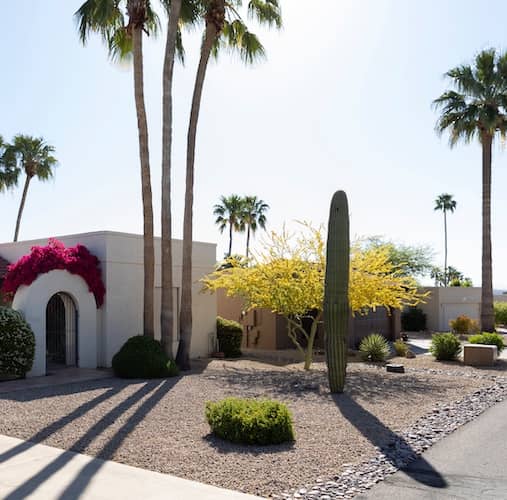A comprehensive guide to mortgage payments on a $300K loan
Feb 16, 2024
•6-minute read
The decision to buy a home often comes with a lot of financial questions. One of the most crucial questions you’ll need to answer is how much you can comfortably afford to spend on monthly mortgage payments.
If you’re home shopping and playing the numbers game, it can help to start with an understanding of what a baseline purchase price, such as $300,000, will look like in practice. Then, as you consider houses over and perhaps under that price point, you’ll better understand your options.
Let’s explore how the mortgage payments on a $300,000 loan could look and highlight important factors to calculate into your total monthly costs. Understanding the relationship between interest rates and the length of your loan term is key to making an informed financial decision about buying a home, and we’ll break this down using a $300,000 mortgage as an example.
Factors that affect monthly mortgage payments
Before crunching the numbers, consider the components that influence your monthly mortgage payment: principal, interest, taxes and insurance, which are sometimes collectively known as PITI.
We’ve focused on calculations around principal and interest rate only – as property taxes and insurance expenses can vary by location and the value of the home. To get the most accurate picture of your costs, factor in your local property tax rate and homeowners insurance, as well as any mortgage insurance you might have to pay.
Down payments can also influence your overall monthly costs. If you can put 20% or more down on a conventional loan, you can avoid paying private mortgage insurance. Another factor in monthly mortgage payments is the length of the loan. A 15-year mortgage will have significantly higher monthly payments but a lower interest rate than a 30-year mortgage.
30- vs. 15-year loan on a $300,000 mortgage
The length of the loan and the interest rate you qualify for will determine how much you pay in total interest. For example, if you opted for a 15-year mortgage with a 7% interest rate, you’d pay a total of $485,367 versus the $718,527 you’d pay with a 30-year mortgage at the same interest rate. That’s a $233,160 difference in total cost. It’s also worth keeping in mind that the interest rate will almost always be lower for a 15-year mortgage. You might, for example, be looking at 6.5% for a 15-year mortgage, versus 7.5% for a 30-year mortgage.
However, the monthly mortgage payment for each loan term is also significantly different. In fact, it’s almost double for the 15-year loan, at $2,696.48. That’s not including property taxes or insurance payments.
Monthly mortgage payments for different terms and rates
Let’s take a look at the different monthly mortgage payments you could have with a $300,000 mortgage based on a 10-, 15-, 20- and 30-year loan term, with an annual percentage rate (APR) of 5% – 7%.
| Annual percentage rate (APR) | Monthly payment (10-year) | Monthly payment (15-year) | Monthly payment (20-year) | Monthly payment (30-year) |
|---|---|---|---|---|
|
5% |
$3,181.97 |
$2,372.38 |
$1,979.87 |
$1,610.46 |
|
6% |
$3,330.62 |
$2,531.57 |
$2,149.29 |
$1,798.65 |
|
7% |
$3,483.25 |
$2,696.48 |
$2,325.90 |
$1,995.91 |
30-year fixed-rate mortgage amortization schedule
Below is an example amortization schedule for a $300,000 loan on a 30-year mortgage at a 7% interest rate. This chart doesn’t include homeowners insurance, mortgage insurance or property taxes. The chart assumes monthly payments of $1,995.91 that are made on time, with no extra mortgage payments applied.
| Year | Beginning balance | Annual interest paid | Annual principal paid |
|---|---|---|---|
|
1 |
$300,000 |
$20,903.46 |
$3,047.43 |
|
2 |
$296,952.57 |
$20,683.16 |
$3,267.73 |
|
3 |
$293,684.84 |
$20,446.94 |
$3,503.95 |
|
4 |
$290,180.89 |
$20,193.64 |
$3,757.25 |
|
5 |
$290,180.89 |
$19,922.02 |
$4,028.87 |
|
6 |
$282,394.77 |
$19,630.78 |
$4,320.11 |
|
7 |
$278,074.66 |
$19,318.48 |
$4,632.41 |
|
8 |
$273,442.24 |
$18,983.60 |
$4,967.29 |
|
9 |
$268,474.95 |
$18,624.51 |
$5,326.38 |
|
10 |
$263,148.57 |
$18,239.47 |
$5,711.42 |
|
11 |
$257,437.15 |
$17,826.59 |
$6,124.30 |
|
12 |
$251,312.85 |
$17,383.86 |
$6,567.03 |
|
13 |
$244,745.82 |
$16,909.13 |
$7,041.76 |
|
14 |
$237,704.06 |
$16,400.08 |
$7,550.81 |
|
15 |
$230,153.25 |
$15,854.23 |
$8,096.66 |
|
16 |
$222,056.60 |
$15,268.93 |
$8,681.96 |
|
17 |
$213,374.63 |
$14,641.31 |
$9,309.58 |
|
18 |
$204,065.05 |
$13,968.32 |
$9,982.57 |
|
19 |
$194,082.48 |
$13,246.67 |
$10,704.22 |
|
20 |
$183,378.26 |
$12,472.87 |
$11,478.02 |
|
21 |
$171,900.23 |
$11,643.12 |
$12,307.77 |
|
22 |
$159,592.46 |
$10,753.39 |
$13,197.50 |
|
23 |
$146,394.96 |
$9,799.34 |
$14,151.55 |
|
24 |
$132,243.41 |
$8,776.32 |
$15,174.57 |
|
25 |
$117,068.84 |
$7,679.35 |
$16,271.54 |
|
26 |
$100,797.31 |
$6,503.08 |
$17,447.81 |
|
27 |
$83,349.50 |
$5,241.78 |
$18,709.11 |
|
28 |
$64,640.39 |
$3,889.29 |
$20,061.59 |
|
29 |
$44,578.79 |
$2,439.04 |
$21,511.85 |
|
30 |
$23,066.94 |
$883.95 |
$23,066.94 |
With this payment schedule, you’ll pay a total of $718,527 over the 30-year period, with $418,527 of that going toward interest.
Before pursuing a $300,000 mortgage, consider how long you plan to live in the home to determine if the costs benefit your long-term financial goals.
You can explore your options for mortgage payments on a $300,000 loan by using the amortization calculator.
How much do I need to make to afford a $300,000 mortgage?
Based on the 28% rule, you shouldn’t put more than 28% of your monthly income toward your mortgage payment. By this standard, you should make at least $7,150 a month or nearly $86,000 a year before taxes: $7,150 x .28 = $2,002 in monthly mortgage payment. This number should include homeowners insurance, property taxes and, perhaps, mortgage insurance.
How much you can afford to apply to a down payment can also influence the final numbers. If you’re looking to buy a home valued at $300,000, you could put more money down to lower your monthly payments. You’ll need to evaluate how much you’ll have left for other expenses and emergencies.
Choosing the right loan terms
Finding your dream home and dealing with sticker shock isn’t easy, but looking at the numbers can be the best way to determine if a purchase is the right choice for you. There’s a lot to calculate. Be sure to add closing costs and other fees – such as those for an appraisal, an inspection, moving costs and potential repairs – to your overall house-buying budget.
Ultimately, your income and the amount of debt you owe will determine whether you can comfortably afford a $300,000 mortgage. Before deciding whether it’s right for you, take into account your monthly debt payments and additional homeownership expenses, such as energy costs and maintenance fees.
Using the mortgage calculator, explore all the factors affecting your monthly mortgage payment. You’ll get an idea of what the different loan terms will mean for your budget.
30-year fixed Vs. 30-year adjustable-rate mortgage (ARM)
Let’s add one more caveat to the mix by looking at an adjustable-rate mortgage (ARM) versus a fixed-rate mortgage. An adjustable-rate mortgage allows you to pay one interest rate for a set period of time before the loan adjusts periodically over the remainder of the loan term.
When looking at the monthly mortgage payments on a $300,000 loan, you might be thinking of an adjustable-rate mortgage as a great way to avoid paying more in interest over the life of the loan. An ARM is a solid option for many home buyers, but if you’re not prepared to make higher monthly mortgage payments in the event that interest rates go up, this strategy could hurt you in the long run.
However, if interest rates drop, you might consider refinancing to a fixed-rate loan. You’ll still have to pay certain fees to refinance, but the savings might be worth the upfront costs if you plan to stay in the home.
How to apply for a $300K mortgage
Before applying for a mortgage, review your financial readiness. Regardless of the length and type of loan you choose, you’ll need to meet certain loan approval requirements, such as an individual lender’s minimum credit score and maximum debt-to-income ratio (DTI).
Start by checking your credit history for any issues that could prevent you from qualifying for a loan. Take inventory of your assets, particularly your savings, to determine how much of a down payment you can afford and how you’ll cover additional expenses such as closing costs and the cost of a home inspection and home appraisal. Next, review your monthly debt payments and determine your DTI.
Once you’ve completed your financial analysis, you can begin researching lenders. Find the one that best meets your needs and begin your application process.
Getting a mortgage preapproval will help you stand out when making an offer while providing you with a better picture of exactly how much house you can afford.
FAQs about monthly mortgage payments on a $300,000 loan
Check out the answers to some frequently asked questions about $300,000 homes and whether buying one will work for your financial situation.
Can I afford a $300K house on a $50K salary?
Affording a $300,000 home and securing a reasonable interest rate with an annual income of $50,000 may require making a sizable down payment, having an excellent credit history and meeting other lender qualifications. Even with satisfying these requirements, you’ll want to be sure you can pay all your regular bills, have enough left over for emergencies and afford your new mortgage payment.
How much is 20% down on a $300,000 house?
Putting 20% down on a $300,000 home requires a $60,000 down payment. However, this size of a down payment isn’t typically required for a loan. It’s worth exploring your options with several lenders to see how much house you can afford.
How does $300,000 compare to the median home price in the U.S.?
The median home price is currently around $430,000, but homes are available for $300,000 and less in most areas of the U.S.
The bottom line: Make an informed money decision
It’s equally important to consider the loan term and interest rate when determining if mortgage payments on a $300,000 loan will be feasible for you. Also include room in your budget for your homeowners insurance, property taxes and any mortgage insurance that may be required.
By thoroughly researching and comparing your mortgage loan options, you’ll be prepared to make the best financial decision for your situation.
Find out what you qualify for with Rocket Mortgage? by applying for a mortgage loan today.

Victoria Araj
Victoria is a former Team Leader of editorial content at Rocket Mortgage and she held roles in mortgage banking, public relations and more in her 19+ years with the company. She holds a bachelor’s degree in journalism with an emphasis in political science from Michigan State University, and a master’s degree in public administration from the University of Michigan.
Related resources

5-minute read
What’s the average mortgage payment in Arizona?
Read more

4-minute read
Mortgage loan limits are on the rise
The Federal Housing Finance Agency updated conforming loan limits, which are rising 3.25% in 2026. Read on for details as well as FHA and VA loan limits...
Read more

7-minute read
What is the average monthly mortgage payment in Georgia?
Discover the average monthly mortgage payment in Georgia, the criteria that affect it, and how it compares nationally. Learn key facts and figures to budget for...
Read more